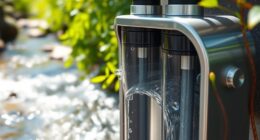To build an EUDR traceability plan, start by mapping your entire supply chain, identifying every link from raw materials to finished products. Collect detailed data on suppliers, sourcing locations, processing facilities, and transportation routes to spot risks like deforestation or labor violations. Organize this information systematically, using secure storage solutions, so it’s easy to update and access. Focusing on high-risk areas and maintaining continuous oversight will help you stay compliant—learn how to develop a robust plan step by step.
Key Takeaways
- Map the entire supply chain, including suppliers, sourcing locations, and transportation routes, to identify potential risks and gaps.
- Prioritize high-risk regions with deforestation or labor issues for targeted data collection and monitoring efforts.
- Organize supply chain data systematically using efficient storage solutions to ensure easy access, security, and ongoing updates.
- Use detailed, verifiable data to demonstrate compliance and facilitate swift responses to regulatory audits or inquiries.
- Continuously review and update the traceability plan to adapt to supply chain changes and maintain EUDR readiness.

With the European Union’s upcoming enforcement of the EUDR, businesses must proactively assess their supply chains and compliance strategies. The first step in building a robust traceability plan is thorough data mapping. You need to identify every link in your supply chain, from raw material extraction to finished products. This involves collecting detailed information about suppliers, sourcing locations, processing facilities, and transportation routes. Data mapping helps you understand where potential risks may lie, such as regions with high deforestation rates or areas with known labor violations. By establishing a clear and extensive data flow, you can pinpoint gaps in your supply chain transparency and prioritize areas for improvement. This process not only aids in compliance but also enhances your ability to respond swiftly to regulatory inquiries or audits. Incorporating vertical storage solutions and other space-maximizing strategies can facilitate the organization of supply chain data and documentation, making the management process more efficient.
Frequently Asked Questions
How Often Should Traceability Data Be Updated?
You should update traceability data regularly to maintain data accuracy and guarantee system integration remains seamless. Ideally, updates happen in real-time or at least daily, depending on your supply chain’s activity level. This frequent updating helps catch discrepancies early and keeps your data reliable. Consistent updates also improve your system’s ability to trace products effectively, supporting compliance and operational efficiency.
What Are Common Challenges in Implementing Traceability Plans?
Think of implementing a traceability plan like assembling a complex puzzle—you need all pieces fitting perfectly. Common challenges include data integration issues, where systems don’t communicate smoothly, and supplier collaboration hurdles, as aligning everyone’s efforts takes effort. These obstacles can slow progress and create gaps in the chain. Staying proactive, fostering open communication, and investing in compatible systems help overcome these hurdles, making the puzzle come together seamlessly.
How Does Traceability Impact Supply Chain Costs?
Traceability impacts your supply chain costs by increasing transparency and accountability, which can lead to higher upfront expenses for tracking systems and data management. However, it also helps you identify inefficiencies and reduce waste, ultimately improving cost management. While implementing traceability may seem costly initially, it can save money long-term by preventing errors, reducing fraud, and ensuring compliance, making your supply chain more efficient and resilient.
What Tools Are Most Effective for Traceability Tracking?
You find digital tools most effective for traceability tracking because they automate data collection and provide real-time updates, reducing errors and improving visibility. While manual methods like spreadsheets can work for small-scale operations, they often fall short in accuracy and efficiency as your supply chain grows. Embracing digital solutions such as blockchain, RFID, or specialized traceability software guarantees thorough, reliable tracking, helping you meet regulatory standards and boost supply chain transparency.
How Can Small Businesses Ensure EUDR Compliance?
Sure, small businesses can easily guarantee EUDR compliance—just focus on supplier verification and seamless data integration. Ironically, the bigger the challenge, the simpler it seems with the right tools; verifying suppliers keeps your supply chain transparent, while data integration consolidates info for quick audits. By staying diligent and leveraging technology, you turn compliance from a headache into a straightforward process, even on a small scale.
Conclusion
Now that you understand the importance of a traceability plan for EUDR readiness, are you ready to take the necessary steps? Building a solid plan helps you stay compliant, manage risks, and demonstrate transparency. Remember, the effort you put in today can save you headaches tomorrow. So, why wait? Start crafting your traceability strategy now and confidently navigate the evolving regulations ahead. After all, your proactive approach is the key to success.









